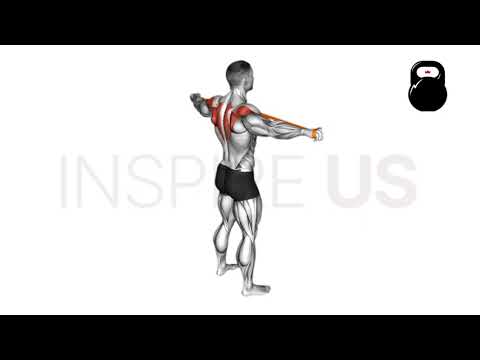Resistance Band Pull Aparts: Benefits, Muscles Worked, and More
Band pull aparts are designated as an compound exercise involving the recruitment of multiple muscle groups - primarily those of the shoulders and upper back.
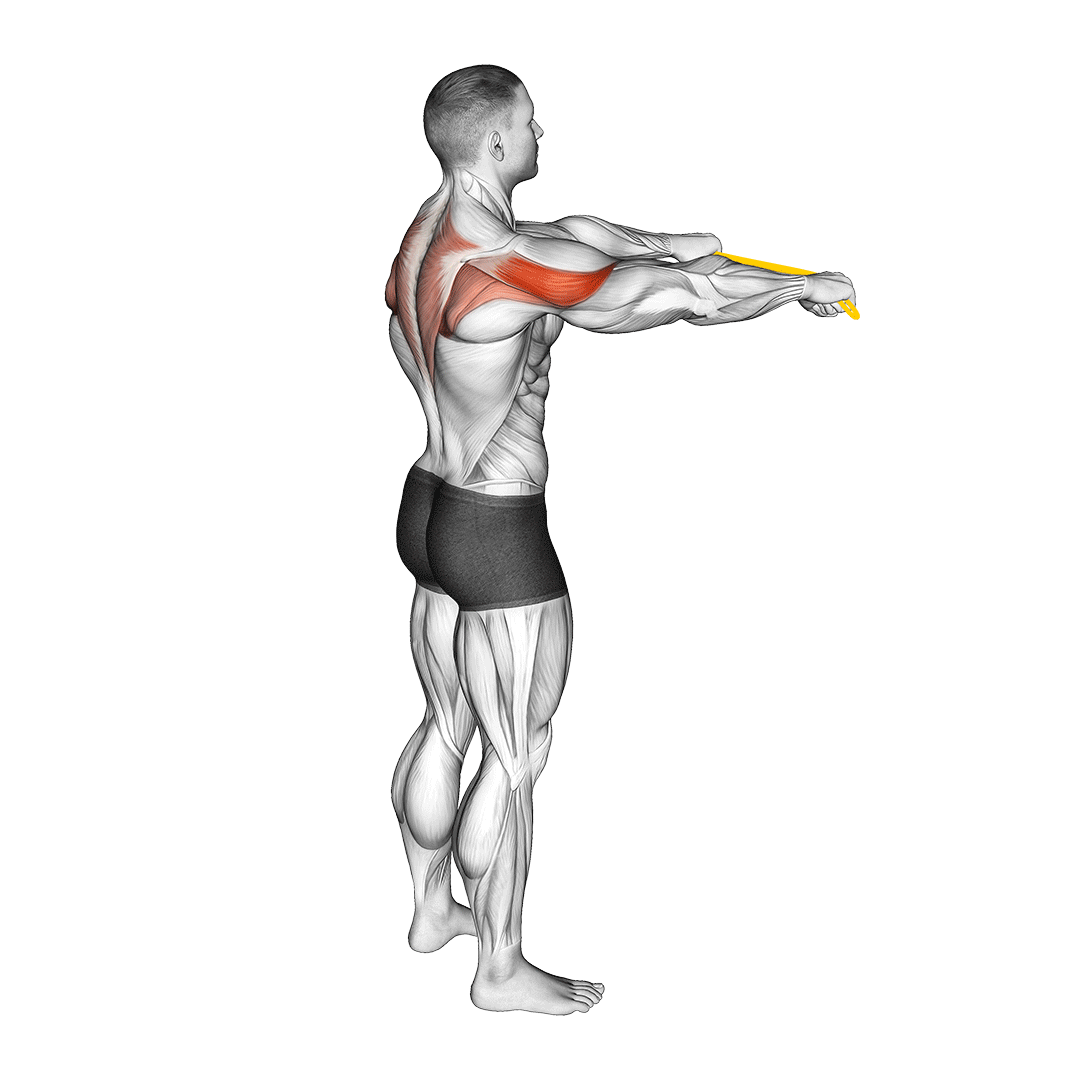
The exercise achieves this recruitment through the use of a resistance band and biomechanics like arm abduction, scapular retraction and external shoulder rotation.
Because of their low joint impact and widely accessible level of complexity, band pull aparts are utilized for a variety of purposes, ranging from physical rehabilitation to bodybuilding training or acting as a warm-up movement.
Of course, the specific purpose with which the band pull apart is performed will dictate how it is programmed and to what extent it is performed. More delicate or intentionally lower-intensity use cases like rehabilitation or warm-ups will require less volume and less resistance.
How to do Band Pull Aparts
To perform a repetition of the band pull apart, the exerciser will begin by first holding a low-resistance band at chest-height in both hands, grip pronated or neutral and shoulder-width apart.
Puffing the chest out, ensuring the torso is upright and the shoulders not internally rotated - the exerciser then pulls the band apart by stretching their arms out to the sides.
This abducting movement should follow in the same direction until the band is pressed against the chest and the upper arms are parallel to the sides of the torso.
As the arms rotate to the sides of the body, the exerciser should simultaneously retract their shoulder blades, pinching them together as the arms reach their maximum range of motion as well.
Now that the initial phase of the repetition is complete, the exerciser releases tension in their scapula and allows the resistance to slowly pull their arms back towards the midline of their body.
Once the arms are back in their starting position shoulder-width apart, the repetition is considered to be complete.
Recommended Sets and Repetitions
If performing the band pull apart for its muscle-building benefits, try 2-3 sets of 12-15 repetitions at a slow pace.
However, if performing the exercise for rehabilitation or as a warm-up, go by your sense of exertion and the advice of your physical therapist. The exact number of repetitions performed will vary on a day to day basis, especially if dealing with a previous injury.
What Muscles are Worked by Band Pull Aparts?
The band pull apart is a compound movement, meaning that multiple muscle groups are worked over the course of its movement pattern.
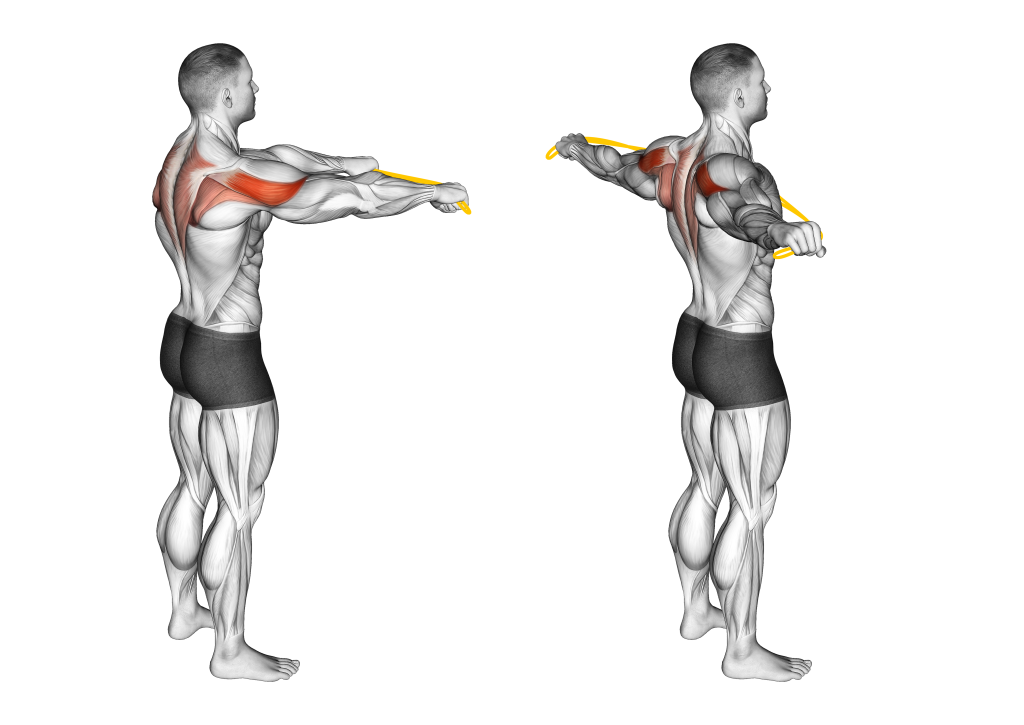
In order for us to better grasp which muscles benefit the most from the band pull apart, we differentiate these muscles by the contraction that they exhibit.
Mobilizer muscles exhibit dynamic contraction, meaning that they receive the most benefit in proportion to their role. In comparison, stabilizer muscles primarily contract isometrically, meaning they do not develop as much as the mobilizer muscles.
Mobilizer Muscles
During a repetition of the band pull apart, the posterior deltoids, trapezius, rhomboids, teres minor and major and the infraspinatus are all targeted to a relatively significant degree.
Of note are the middle trapezius, rhomboids and the posterior deltoids, as they are recruited throughout the entire range of motion at a steady level of tension.
Stabilizer Muscles
Alongside the mobilizer muscles, the pectoral muscles, remaining two deltoid heads and elbow flexor muscles are also contracted isometrically to help stabilize the movement.
What are the Benefits of Doing Band Pull Aparts?
The band pull apart is so widely adopted due to the breadth of advantages it offers the exerciser - ranging from rehabilitation of specific rotator cuff disorders to the development of greater shoulder strength.
Strengthens Posterior Deltoids and Upper Back
The more general benefits of the band pull apart lie in its capacity to build muscle mass and strength around the upper back - especially in the middle trapezius, rear delt and rhomboids.
Because these muscles help move the rotator cuff, scapula and shoulder joint, they receive a constant time under tension through a relatively large range of motion as the pull apart is performed.
In turn, this leads to a moderate amount of hypertrophy and excellent strength development.
What makes the band pull apart such an asset in general resistance training programs is that it targets the smaller muscles of the upper back and shoulders - of which are rarely directly worked to such a capacity.
Reinforces Shoulder Rotation, Arm Abduction, Scapular Retraction and Depression
With each muscle group targeted by band pull aparts being an integral mover of many biomechanical functions, it’s no surprise that the exercise is used for reinforcing overall movement of the scapula and shoulder joint itself.
In particular are external rotation of the shoulder joint, abduction of the arms as well as retraction and depression of the scapula.
These mechanics are vital for healthy upper body function, and are utilized in activities ranging from dumbbell lateral raises and pull-ups to everyday movement.
Of course, if you have symptoms of disordered movement in these areas, speak to a medical professional prior to attempting any form of self-rehabilitation.
Truly Multi-Purpose
Although many exercises fulfill multiple purposes within the grand scheme of a training program, the band pull apart excels such a definition by being used for warming up, rehabilitation, mobility and general muscular development.
Depending on the resistance, time under tension, range of motion and volume programmed, the band pull apart is easily modified to meet the needs of such goals - even with the underlying movement pattern being much the same.
Accessible, Simple and Convenient
A hallmark of resistance band exercises is convenience and accessibility. One can even take a resistance band with them on vacation, allowing for a decent workout in a highly convenient manner.
These aspects - combined with the overall simplicity of the band pull apart - create an exercise that is entirely accessible to the majority of healthy individuals, even for novices or those with average shoulder mobility.
Improves Stability, Control and Muscular Endurance
Apart from building strength and developing mass in the upper back and shoulders, the band pull apart is also employed for developing stability, control and endurance in these muscles as well.
With a lengthy and consistent time under tension throughout its range of motion, the deltoids, rotator cuff muscles and elbow flexors are all contracted in a manner that builds isometric strength and endurance while under tension.
To get the most out of band pull aparts in this respect, aim to stretch out each repetition for a sufficiently long period. 3-4 seconds should be suitable if not longer.
Common Band Pull Apart Mistakes to Avoid
While it is indeed true that band pull aparts are among the safest of exercises, avoid the following mistakes in order to get the most out of performing them.
Fully Extending Elbow
During a repetition of the band pull apart, the arms should be relatively straight - however, the elbows should not be entirely locked out. Doing so can place undue torsion on the shoulder joint and make the exercise more difficult overall.
Allow some level of flexion in the elbows throughout the exercise, especially as the arms rotate outwards during the initial phase of the repetition.
Internally Rotating Shoulders
Also known as rounding the shoulders; avoid allowing the shoulders to rotate internally when performing the band pull apart.
Not only will this greatly increase strain within the joint itself, but the positioning the deltoids in this manner greatly reduces the amount of force they will be able to output as the arms abduct beyond the parallel point.
At the start and end of the repetition, the shoulders should be at least in a neutral position, rotating externally as the arms rotate beyond shoulder-width.
Hunching Shoulders/Elevating Scapula
In order to correctly target the upper and middle back musculature, the scapula should be both pinched together and depressed simultaneously at the apex of the movement.
Allowing the trapezius or shoulders to hunch up towards the ears achieves the opposite effect, and can make the exercise overall less focused on muscles like the rhomboids or deltoids.
Poor Time Under Tension and Usage of Momentum
Band pull aparts rely on sufficient time under tension to develop the muscles of the shoulders and back properly.
Rushing through the movement or utilizing momentum to make it easier can negate this sort of training stimulus, defeating the purpose of the exercise and potentially leading to injury.
Aim to not only stretch out the length of each repetition, but also to focus on slow and controlled musculature contraction throughout said repetition.
Jerking, shifting the torso or generating momentum in any other manner can be a sign that the band’s resistance is too high for your current strength level.
Alternatives and Variations to the Band Pull Apart
If you don’t have access to a resistance band - or want to try something more intense - check out the following alternative exercises.
Face Pulls
Face pulls are a machine-based compound movement performed to develop the upper back and rear delts in a similar manner to the band pull apart.
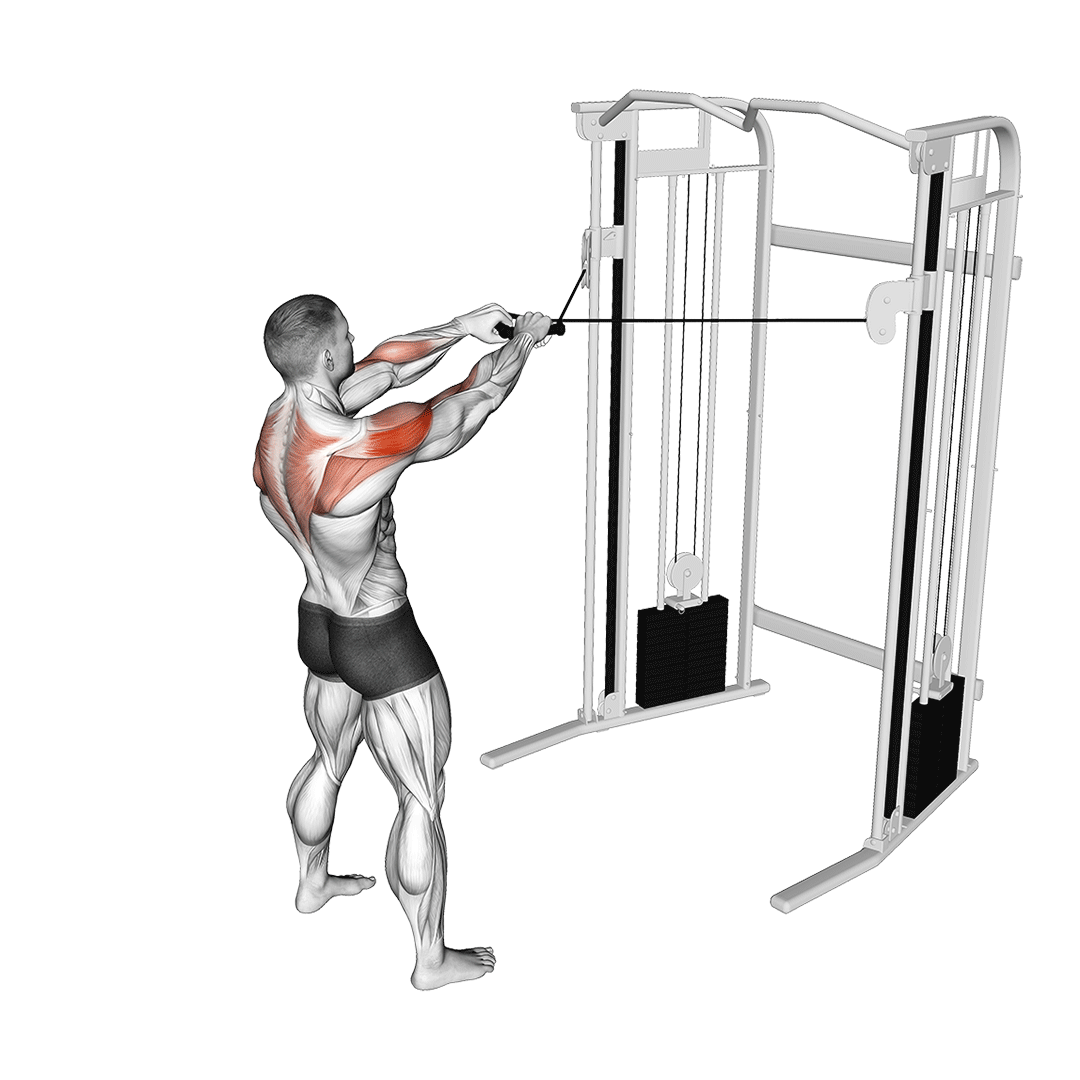
However, rather than drawing the arms out to the sides against resistance, the face pull quite literally involves the lifter pulling a rope towards their face. This creates greater emphasis on the upper trapezius and posterior deltoids while producing less torsion in the shoulder joint.
Band Reverse Flys
Band reverse flys are a more deltoid-focused alternative to band pull aparts where the center of the band is anchored to a point at chest-height away from the exerciser. Gripping both ends, they then spread their arms out to the sides, pulling the band away from the anchor as they do so.
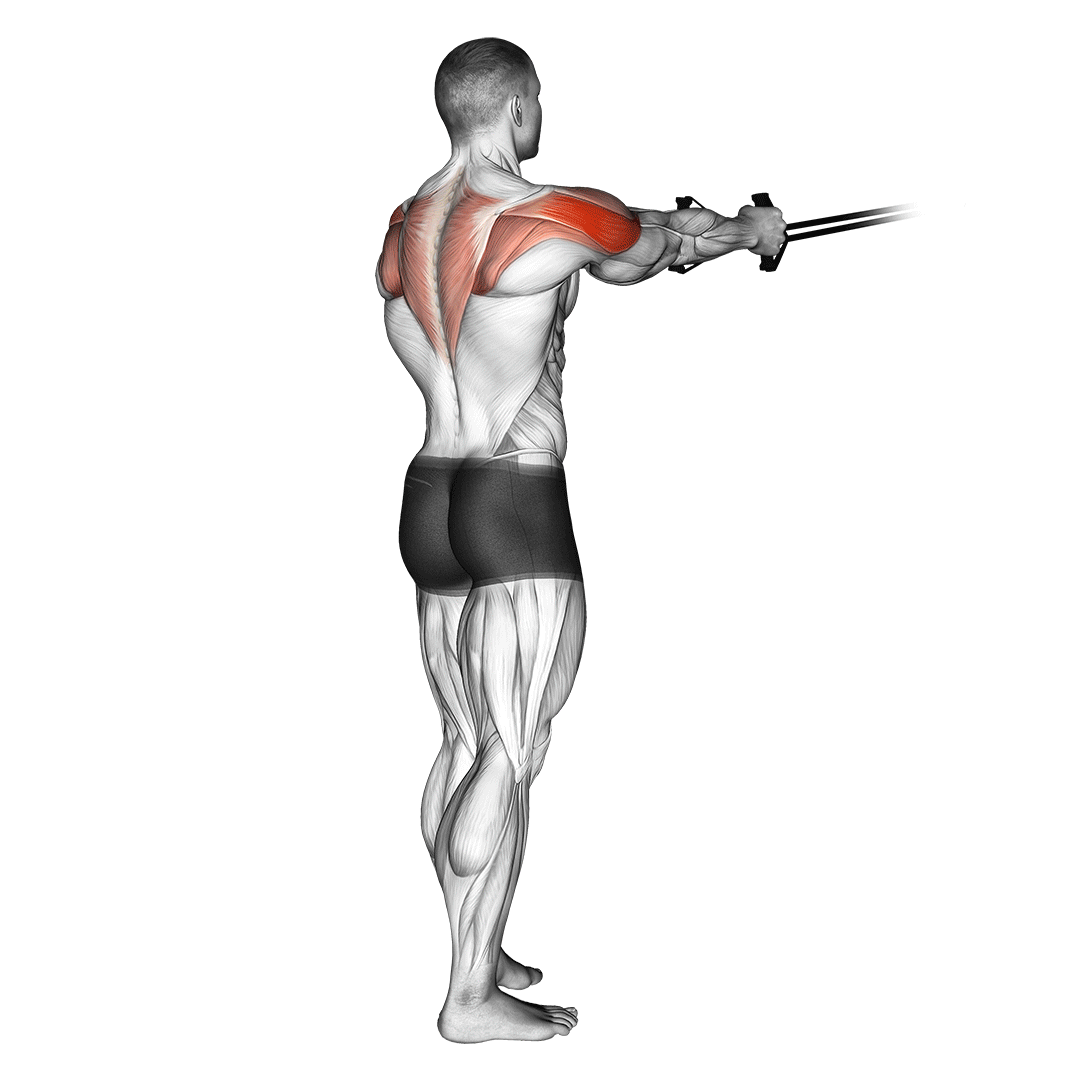
Banded reverse flys emphasize the elbow flexors and latissimus dorsi muscles to a greater degree than band pull aparts, trading in this advantage for somewhat less trapezius and posterior deltoid recruitment.
Scapular Push-Ups
Scapular push-ups are a calisthenic exercise meant to target the often-forgotten serratus anterior muscle. As one can likely guess from its name, the exercise is also used to diagnose and treat issues with scapular movement.
In otherwise healthy performers, scapular push-ups serve the rather unique purpose of reinforcing scapular protraction and retraction in a conscious manner.
They may also be used to substitute the band pull apart in training programs where the latter serves a more technical purpose than simple muscular development.
Frequently Asked Questions (FAQ)
What is the Purpose of Banded Pull Aparts?
Band pull aparts serve a truly diverse range of purposes, ranging from simple development of the rear delts and upper back to rehabilitation or warming up.
What is the Hand Position for Band Pull Aparts?
Band pull aparts can be performed with either a pronated or neutral grip, but the latter is far more preferable entirely because it strains the shoulder joint to a lesser extent.
Do Band Pull Aparts Fix Posture?
Yes - but only in specific parts of the body.
Band pull aparts target the trapezius, rotator cuff muscles and the posterior deltoids. This means that they help correct posture issues related to shoulder rotation or curvature of the upper back.
References
1. Fukunaga T, Fedge C, Tyler T, Mullaney M, Schmitt B, Orishimo K, McHugh M, Nicholas S. Band Pull-Apart Exercise: Effects of Movement Direction and Hand Position on Shoulder Muscle Activity. Int J Sports Phys Ther. 2022 Apr 2;17(3):400-408. doi: 10.26603/001c.33026. PMID: 35391860; PMCID: PMC8975561.
2. Burkhead WZ Jr, Rockwood CA Jr. Treatment of instability of the shoulder with an exercise program. J Bone Joint Surg Am. 1992;74(6):890-896. doi:10.2106/00004623-199274060-00010

